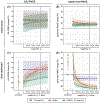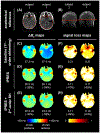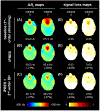Application of an integrated radio-frequency/shim coil technology for signal recovery in fMRI
- PMID: 34288086
- PMCID: PMC8568668
- DOI: 10.1002/mrm.28925
Application of an integrated radio-frequency/shim coil technology for signal recovery in fMRI
Abstract
Purpose: Gradient-echo echo-planar imaging (EPI), which is typically used for blood oxygenation level-dependent (BOLD) functional MRI (fMRI), suffers from distortions and signal loss caused by localized B0 inhomogeneities. Such artifacts cannot be effectively corrected for with the low-order spherical harmonic (SH) shim coils available on most scanners. The integrated parallel reception, excitation, and shimming (iPRES) coil technology allows radiofrequency (RF) and direct currents to flow on each coil element, enabling imaging and localized B0 shimming with one coil array. iPRES was previously used to correct for distortions in spin-echo EPI and is further developed here to also recover signal loss in gradient-echo EPI.
Methods: The cost function in the shim optimization, which typically uses a single term representing the B0 inhomogeneity, was modified to include a second term representing the signal loss, with an adjustable weight to optimize the trade-off between distortion correction and signal recovery. Simulations and experiments were performed to investigate the shimming performance.
Results: Slice-optimized shimming with iPRES and the proposed cost function substantially reduced the signal loss in the inferior frontal and temporal brain regions compared to shimming with iPRES and the original cost function or 2nd -order SH shimming with either cost function. In breath-holding fMRI experiments, the ΔB0 and signal loss root-mean-square errors decreased by -34.3% and -56.2%, whereas the EPI signal intensity and number of activated voxels increased by 60.3% and 174.0% in the inferior frontal brain region.
Conclusion: iPRES can recover signal loss in gradient-echo EPI, which is expected to improve BOLD fMRI studies in brain regions suffering from signal loss.
Keywords: B0 shimming; BOLD fMRI; gradient-echo EPI; human brain; iPRES; signal recovery.
© 2021 International Society for Magnetic Resonance in Medicine.
Figures








Similar articles
-
Integrated parallel reception, excitation, and shimming (iPRES) with multiple shim loops per radio-frequency coil element for improved B0 shimming.Magn Reson Med. 2017 May;77(5):2077-2086. doi: 10.1002/mrm.26267. Epub 2016 May 13. Magn Reson Med. 2017. PMID: 27174387 Free PMC article.
-
Adaptive integrated parallel reception, excitation, and shimming (iPRES-A) with microelectromechanical systems switches.Magn Reson Med. 2018 Jul;80(1):371-379. doi: 10.1002/mrm.27007. Epub 2017 Nov 16. Magn Reson Med. 2018. PMID: 29148102 Free PMC article.
-
Integrated RF/shim coil array for parallel reception and localized B0 shimming in the human brain.Neuroimage. 2014 Dec;103:235-240. doi: 10.1016/j.neuroimage.2014.09.052. Epub 2014 Sep 28. Neuroimage. 2014. PMID: 25270602 Free PMC article.
-
In vivo B0 field shimming methods for MRI at 7T.Neuroimage. 2018 Mar;168:71-87. doi: 10.1016/j.neuroimage.2017.06.013. Epub 2017 Jun 7. Neuroimage. 2018. PMID: 28602943 Free PMC article. Review.
-
Advancements in MR hardware systems and magnetic field control: B0 shimming, RF coils, and gradient techniques for enhancing magnetic resonance imaging and spectroscopy.Psychoradiology. 2024 Aug 14;4:kkae013. doi: 10.1093/psyrad/kkae013. eCollection 2024. Psychoradiology. 2024. PMID: 39258223 Free PMC article. Review.
Cited by
-
An iPRES-W Coil Array for Simultaneous Imaging and Wireless Localized B0 Shimming of the Cervical Spinal Cord.Magn Reson Med. 2022 Aug;88(2):1002-1014. doi: 10.1002/mrm.29257. Epub 2022 Apr 25. Magn Reson Med. 2022. PMID: 35468243 Free PMC article.
-
Flexible multi-purpose integrated RF/shim coil array for MRI and localized B0 shimming.Magn Reson Med. 2024 Feb;91(2):842-849. doi: 10.1002/mrm.29891. Epub 2023 Oct 17. Magn Reson Med. 2024. PMID: 37849021 Free PMC article.
-
Impact of through-slice gradient optimization for dynamic slice-wise shimming in the cervico-thoracic spinal cord.Magn Reson Med. 2025 Sep;94(3):1090-1102. doi: 10.1002/mrm.30543. Epub 2025 May 1. Magn Reson Med. 2025. PMID: 40312894 Free PMC article.
-
Recent Advances in Radio-Frequency Coil Technologies: Flexible, Wireless, and Integrated Coil Arrays.J Magn Reson Imaging. 2022 Apr;55(4):1026-1042. doi: 10.1002/jmri.27865. Epub 2021 Jul 29. J Magn Reson Imaging. 2022. PMID: 34324753 Free PMC article. Review.
References
-
- Constable RT. Functional MR imaging using gradient-echo echo-planar imaging in the presence of large static field inhomogeneities. J Magn Reson Imaging 1995;5:746–752. - PubMed
-
- Glover GH. 3D z-shim method for reduction of susceptibility effects in BOLD fMRI. Magn Reson Med. 1999;42(2):290–299. - PubMed
-
- Song AW. Single-shot EPI with signal recovery from the susceptibility-induced losses. Magn Reson Med. 2001;46(2):407–411. - PubMed
-
- Truong TK, Song AW. Single-shot dual-z-shimmed sensitivity-encoded spiral-in/out imaging for functional MRI with reduced susceptibility artifacts. Magn Reson Med. 2008;59(1):221–7. - PubMed
-
- Hsu JJ, Glover GH. Mitigation of susceptibility-induced signal loss in neuroimaging using localized shim coils. Magn Reson Med. 2005;53(2):243–8. - PubMed
Publication types
MeSH terms
Grants and funding
LinkOut - more resources
Full Text Sources
Medical

